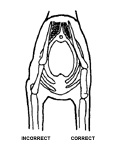


A Closer Look at the
Chihuahua
by Laurence Fitt-Savage
Shoulder

The shoulder, as the foundation upon which the forequarters are based, should be correctly laid, the most efficient arrangement is generally accepted to be 45° from the horizontal (side view). An upright shoulder (an angle significantly greater than 45°) tends to shorten the shoulder blade, thereby also shortening the muscles anchored to it, reducing their efficiency. There is also a loss of reach, as the foreleg cannot straighten beyond the angle of the shoulder, and this reduces drive and is the root of a number of serious gaiting faults.
The shoulders are also required to be 'lean, sloping into slightly broadening support'. This refers to the view from the front of the dog. The shoulders lay along the ribs; too much muscle on the shoulder pushes the tops of the shoulder blades apart. These 'loaded shoulders' are heavy, rather than lean, and result in a lack of balance. The shoulder point is tied in closer to the ribcage and the elbow is forced out of line, which is an ugly fault. A dog with loaded shoulders may also appear overbuilt at the front, tailing off to weaker hindquarters.
[ Next ]
Skull ::
Jaws and Cheeks ::
Muzzle ::
Bite ::
Eyes ::
Ears ::
Neck ::
Forequarters
Shoulder ::
Movement ::
Balance ::
Forehand ::
Foreaction ::
Musculature
Hindquarters ::
Hindaction ::
Croup ::
Angulation ::
Back ::
Body Shape ::
Chest ::
Tail
Reproduced from the British Chihuahua Club Handbook 1987